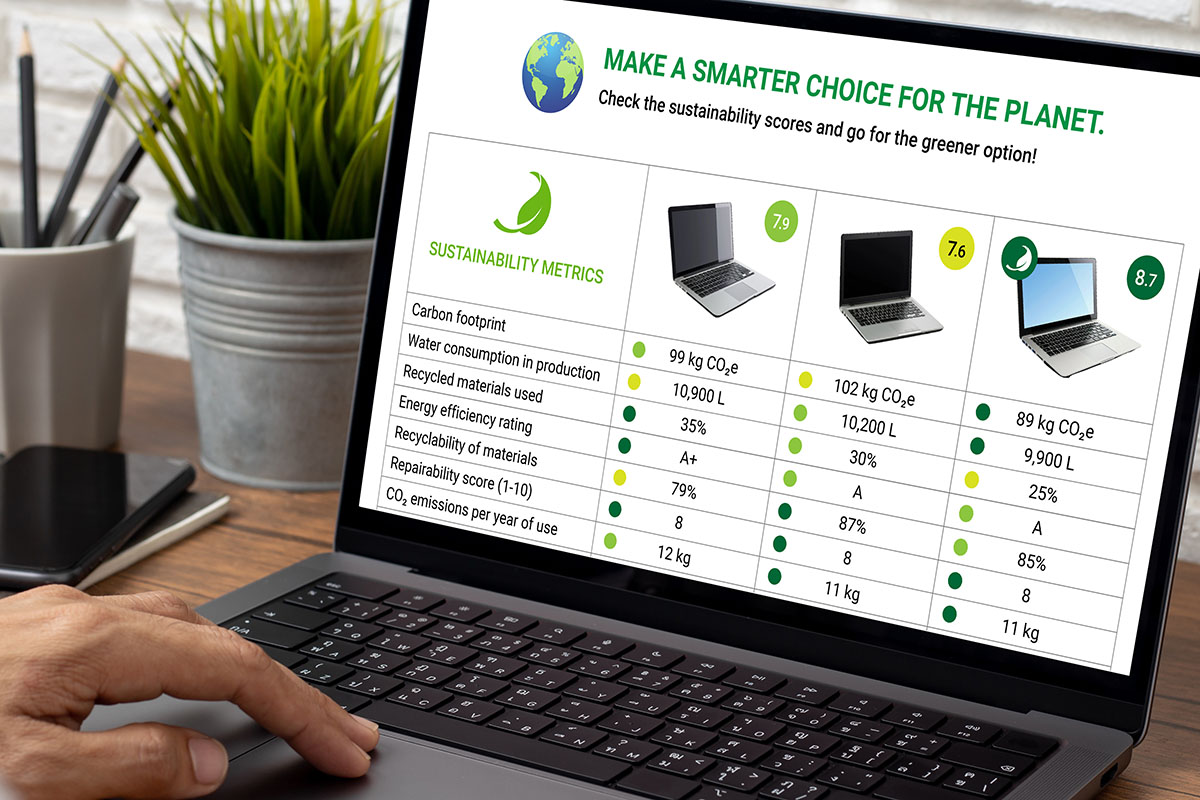
Digital Product Passport: Tips to Unlock New Opportunities in E-Commerce
The Digital Product Passport (DPP) is not just an obligation — it is a unique opportunity for e-commerce companies to gain a competitive edge.
In this article, we provide tips and hints on how online retailers can creatively use DPP to boost customer engagement, promote sustainable choices, and differentiate themselves in the market. They reflect the expert perspective of Jacek Polkowski, Marketing & Communication Manager at Striped Giraffe.

JACEK POLKOWSKI
Marketing & Communication Manager
Striped Giraffe
DPP Accessibility for Online Consumers
While the exact regulatory requirements for e-commerce platforms are not yet determined, it is certain that online retailers will be obliged to provide some form of access to the digital passport directly on the product page.
If information is not presented in direct connection with the product, crucial details about sustainability, composition, or recyclability might only become available after delivery and scanning the QR code. That would defeat the very purpose of the DPP, which aims to empower consumers with transparency upfront.
With that in mind, let’s explore what the DPP means for e-commerce businesses and the opportunities it presents in an increasingly sustainability-driven market.
Flexible Implementation Approaches
While e-commerce platforms will be required to provide access to DPP data, the specific method of implementation will likely remain at their discretion.
Two primary approaches stand out: linking to an external source, such as an official EU registry, or integrating and displaying the full DPP data directly in the online store.
A simple hyperlink to an external repository is the most straightforward solution, ensuring compliance with minimal technical effort. For that reason, it is optimal especially for smaller online stores, which usually have limited personnel and financial resources as well as often rely on simpler SaaS e-commerce platforms with significantly fewer customization capabilities.
On the other hand, many larger retailers may prefer to import DPP data and present it within their own platforms to retain customer engagement and provide a seamless shopping experience. This approach ensures that shoppers do not need to leave the site to access sustainability and product lifecycle details elsewhere.

Optimized Product Page Design
For the best user experience, larger e-commerce platforms may want to integrate DPP data directly into product pages — either as a dedicated block of information in the product description or as a separate tab.
Some online retailers may take this a step further by creating a dedicated section on their platform that consolidates digital passports for all items they sell. In this case, a product page would simply include a link to its corresponding DPP within the same digital environment.
The final scope of information that the EU will require to be shared with consumers through DPPs has not yet been defined. One thing is certain: if a retailer decides to host DPPs directly on their e-commerce platform, they will need to publish all mandated data. However, displaying all the information directly on the product page could clutter it with excessive content, as not all details may be equally important to every customer.
In such cases, a hybrid approach could emerge as the most effective solution: displaying key sustainability highlights directly on the product page while linking to a more detailed breakdown for those who want to explore further. This ensures that the most critical information is immediately accessible, while the full DPP remains available for deeper insights.
To help you prepare for the Digital Product Passport, we have created a concise booklet with key insights including:
- How DPP works
- What data is included
- Which product categories are affected
- The underlying legal framework
- Key milestones on the implementation timeline
Enhanced Visualization for Consumer Engagement
While the EU will require e-commerce businesses to share DPP data with consumers, it will not dictate how this information should be presented visually. This means retailers will not be obligated to display raw data in plain text and will have the freedom to develop their own methods for visually enhancing sustainability attributes.
Online retailers can leverage visual elements such as icons, infographics, interactive charts, or images to make the data more engaging. For example, a clothing retailer can use a graphical scale to indicate where a particular product falls in terms of water consumption during production.
Dynamic elements, such as animations or comparative visualizations, could further enhance the shopping experience. A furniture store, for instance, could create an interactive module showing how different sofas rank in terms of recyclability or material sourcing.

Product Comparisons Based on Sustainability Criteria
With standardized DPP data, online businesses can enhance their product comparison tools by adding sustainability metrics alongside traditional parameters like price, dimensions, or technical specifications.
For example, a customer comparing washing machines could evaluate models not just by energy consumption or capacity, but also by factors such as CO2 emissions during production, recyclability, or the percentage of recycled materials used. Similarly, a shopper looking at smartphones could compare repairability scores or the carbon footprint of each device.
This integration of DPP data into comparison tools empowers consumers to make more informed, sustainability-driven purchasing decisions.
Personalized Shopping Experiences
Many e-commerce platforms already utilize personalization engines to tailor product recommendations based on browsing behavior. Integrating DPP data into these systems can enable sustainability-conscious consumers to receive product recommendations aligned with their values.
For instance, a customer who frequently purchases organic or eco-friendly items may see a curated selection of products with the lowest environmental impact.
Relevant filters can also be applied automatically during a search, ensuring that a shopper looking, for example, for home appliances sees energy-efficient options first.
Promoting Eco-Friendly Choices
Sellers can use DPP data to highlight and promote products that meet the highest sustainability standards. Dedicated sustainable product categories could be introduced, such as Zero-Waste Fashion, Non-Toxic Cleaning Products or Most Recyclable Electronics.
Product filtering and sorting options as well as searching criteria could also include sustainability features, enabling customers to prioritize the most eco-conscious choices.
Additionally, e-commerce platforms could display sustainability insights at the checkout stage.
For instance, a customer purchasing multiple items could see an aggregated summary of the environmental impact of their cart, along with suggested swaps for greener alternatives.

It is All About the Data
Every idea presented above relies on one key element: the effective use of data from digital passports. For online businesses, this means not only accessing and processing this data but also integrating it seamlessly into their operations.
One thing is clear: retailers will not be required to collect product lifecycle data or create DPPs for the products they sell. That responsibility lies primarily with manufacturers. Retailers’ role is to ensure consumers can access this information. However, ambitious businesses will likely go further, leveraging DPP data to build competitive advantages.
To access this data, retailers will need to establish integrations between their systems (such as ERP or PIM) and external systems hosting official DPPs. But this is not a one-time task. DPP data is not static and may need to be updated every time some factors change, such as production methods or materials used.
This means retailers cannot simply pull the data once and forget about it. They will need mechanisms to synchronize and verify that their internal systems reflect the most current information.
Retailers already store some DPP-related data in their PIM or ERP systems, such as technical specifications, energy consumption, or product origin. However, integrating this with DPP data may lead to conflicts. For example, if a TV’s energy consumption in the DPP differs from the retailer’s existing data, the DPP information should take precedence. Retailers will need to reconcile these differences and ensure their systems align with the official DPP.
The DPP will not apply to all product categories at once. The EU is introducing it gradually, starting with specific sectors like electronics and textiles, with others to follow. This means retailers with diverse product portfolios must monitor which categories fall under DPP requirements and when.
Moreover, the regulatory landscape is still evolving. While the DPP framework is taking shape, many details remain undefined. Retailers must stay agile, as updates and new guidelines are likely to emerge once the system is in practice.
You may also like:
- Blog article: “Digital Product Passport: Data Management Challenges”
- E-book: “ESG – It is our responsibility”
- Booklet (PDF): “Digital Product Passport: All you need to know”


